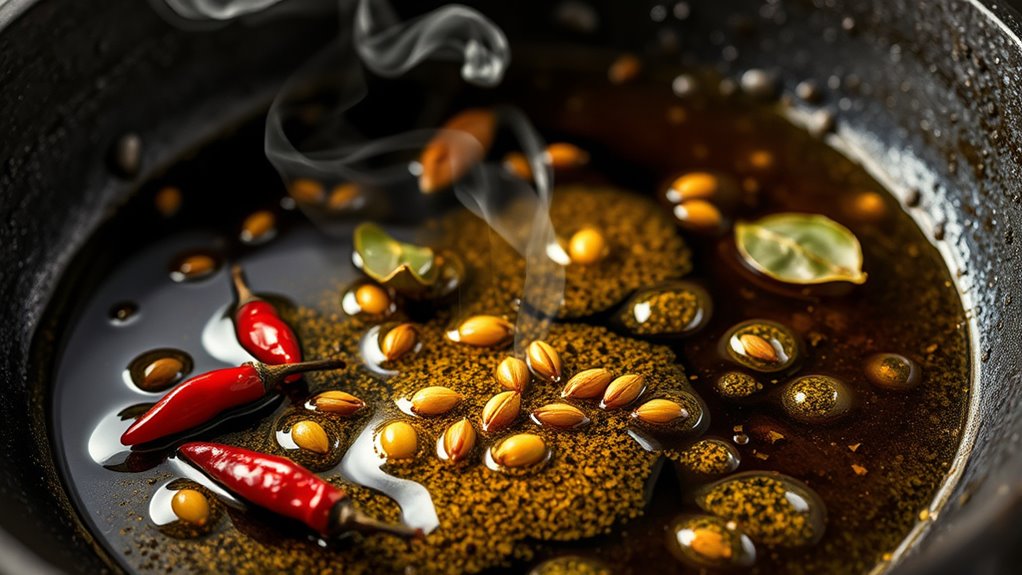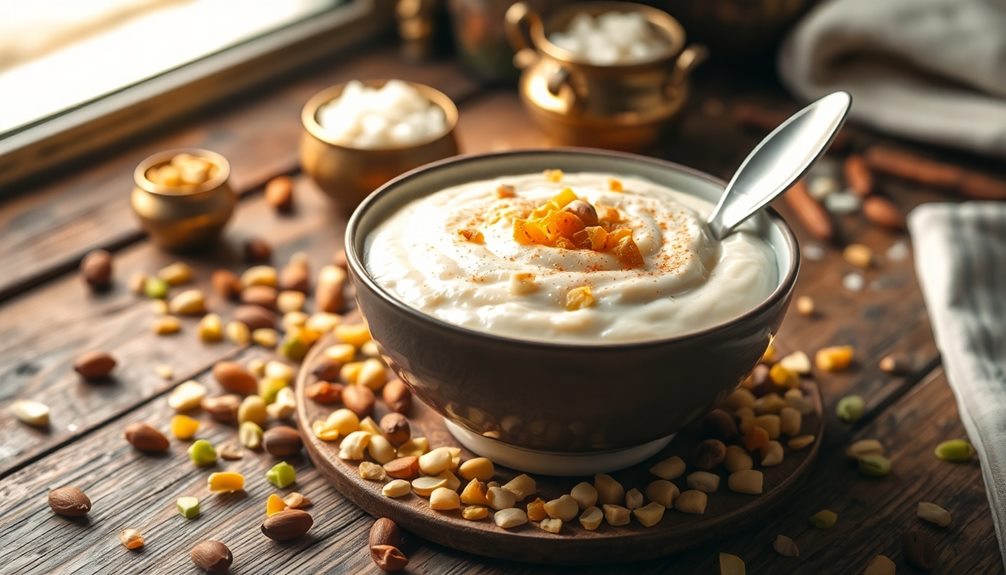When making Indian tadka, choosing the right oil with a suitable smoke point is key. High smoke point oils like ghee or mustard oil prevent burning and release spices’ aromatic oils effectively. Heating the oil triggers chemical reactions like the Maillard process, intensifying flavors and aromas. Proper timing in spice addition guarantees balanced flavor development without bitterness. Keep exploring to discover how mastering these details can elevate your everyday cooking.
Key Takeaways
- Choosing oils with high smoke points, like ghee or mustard oil, ensures spices are tempered without burning or releasing harmful compounds.
- Proper oil temperature during tempering releases essential spice aromas through chemical reactions like Maillard and caramelization.
- The smoke point of an oil determines its suitability for tempering, preventing flavor loss and undesirable bitterness.
- Spices like cumin and dried chilies crackle when heated to the right temperature, indicating optimal aroma release during tempering.
- Understanding spice chemistry and oil properties helps enhance flavor, aroma, and safety in traditional Indian tadka preparation.

Indian tadka tempering is a critical step that instantly elevates the flavor of your dishes. The way you select your cooking oil and how you develop spice aroma play essential roles in achieving that perfect, aromatic burst of flavor. When you’re starting your tempering, choosing the right cooking oil is indispensable because it influences both the cooking process and the final taste. Different oils have various smoke points, which is the temperature at which they start to produce smoke and break down, releasing unwanted flavors and potentially harmful compounds. For tempering, you want an oil with a high enough smoke point to withstand the heat needed to release the essential oils from your spices without burning them. Common choices include ghee, mustard oil, or vegetable oils like canola and sunflower, all of which offer good heat stability and contribute unique flavors.
Once you’ve selected your ideal oil, the focus shifts to spice aroma development. When you heat the oil, it’s not just about getting it hot; it’s about creating the perfect environment for your spices to release their essential oils and aromatic compounds. As the oil reaches the right temperature, you add your spices—such as cumin seeds, mustard seeds, or dried red chilies—and hear that initial crackle. This sound signals that the spices are starting to toast and release their fragrant oils, which is the key to developing that rich aroma that defines Indian dishes. If you add spices too early, they may burn or become bitter; too late, and you miss out on the full aroma potential. The goal is to find that sweet spot where the spices sizzle gently, releasing their flavors without burning.
The chemistry behind spice aroma development is fascinating. When spices are heated in oil, volatile aromatic compounds are released, creating layers of flavor that permeate the dish. The heat causes chemical reactions like the Maillard reaction and caramelization, which deepen the aroma and flavor profile. Proper oil selection ensures these reactions happen at the right temperature, without smoke or bitterness, allowing you to maximize flavor extraction. Using oils with appropriate smoke points can also help prevent the formation of harmful compounds during cooking. Additionally, awareness of the oil smoke point can help prevent the formation of harmful compounds during cooking. Knowing the smoke point of different oils allows you to choose the best oil for your cooking method, ensuring both flavor and safety. Choosing oils with suitable smoke points not only enhances flavor but also contributes to the longevity of your cooking oils, making them more economical and sustainable. So, when you master the art of choosing your cooking oil and timing your spice addition, you set the foundation for a flavorful, aromatic Indian meal that’s truly authentic.
Frequently Asked Questions
How Does Oil Smoke Point Affect Tadka Flavor?
When you cook with oil, the smoke point critically impacts your tadka flavor. If the oil reaches its smoke point, it can burn and develop a bitter taste, hindering flavor development. Using oils with higher smoke points allows you to temper spices at higher temperatures, enhancing aroma and depth. As a result, choosing the right oil guarantees your tadka remains flavorful, vibrant, and free from burnt, unpleasant notes.
What Spices Are Best for High-Temperature Tempering?
When it comes to high-temperature tempering, you should choose spices that withstand heat well, promoting spice roasting and flavor development without burning. Whole spices like cumin seeds, mustard seeds, and black peppercorns are ideal because they resist high heat better than ground spices. These spices release their essential oils, enhancing aroma and flavor during tempering, making your dish more flavorful while avoiding bitterness from over-roasting.
Can Tempering Change the Nutritional Value of Spices?
You might wonder if tempering can change the nutritional value of spices. It can, to some extent, affect nutritional preservation by degrading heat-sensitive vitamins and antioxidants. However, tempering can also enhance spice bioavailability, making nutrients easier for your body to absorb. So, while some nutrients may diminish, the overall flavor and health benefits can improve, giving you a richer, more nutritious experience with your dish.
How Do Different Oils Influence Spice Release During Tempering?
When you use different oils for tempering, you influence how spices release their flavors. Heavier oils like sesame or mustard tend to enhance oil absorption and improve spice dispersion, making flavors more vibrant. Lighter oils, such as vegetable or sunflower, might result in less oil absorption but still help distribute spices evenly. Choosing the right oil depends on the desired intensity of spice aroma and the dish’s overall flavor profile.
What Are Common Mistakes in Indian Tadka Tempering?
Imagine you’re a chef in a bustling kitchen, yet many make mistakes in tadka tempering. You might overheating spices, which burns their flavor, or choose improper oil, causing smoky chaos. Rushing the process, skipping seasoning, or adding spices too early can also ruin the dish. Pay attention to heat, select the right oil, and add spices at the right moment to elevate your Indian tadka perfectly.
Conclusion
Now, as you master Indian tadka tempering, remember that each spice and oil choice can transform your dish in unexpected ways. Will the next batch bring a perfect aroma or an unforeseen twist? The secrets hidden in oil smoke points and spice chemistry hold the key. Keep experimenting, stay curious, and you might just reveal flavors that surprise even you. Are you ready to discover what’s truly possible in your kitchen? The journey has only just begun.









